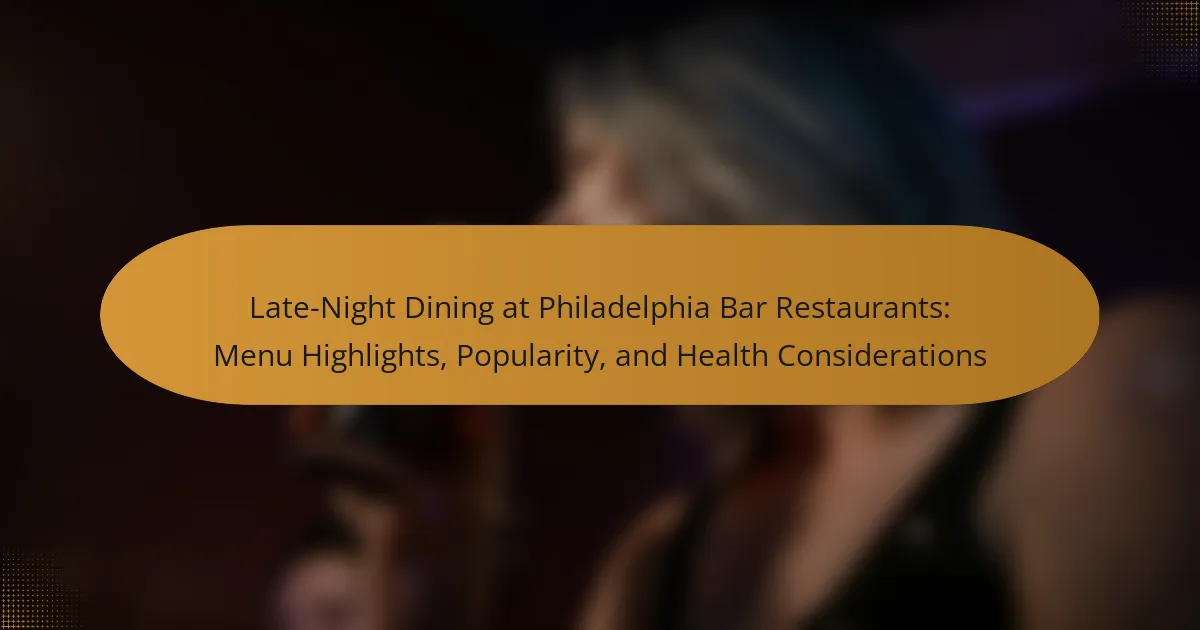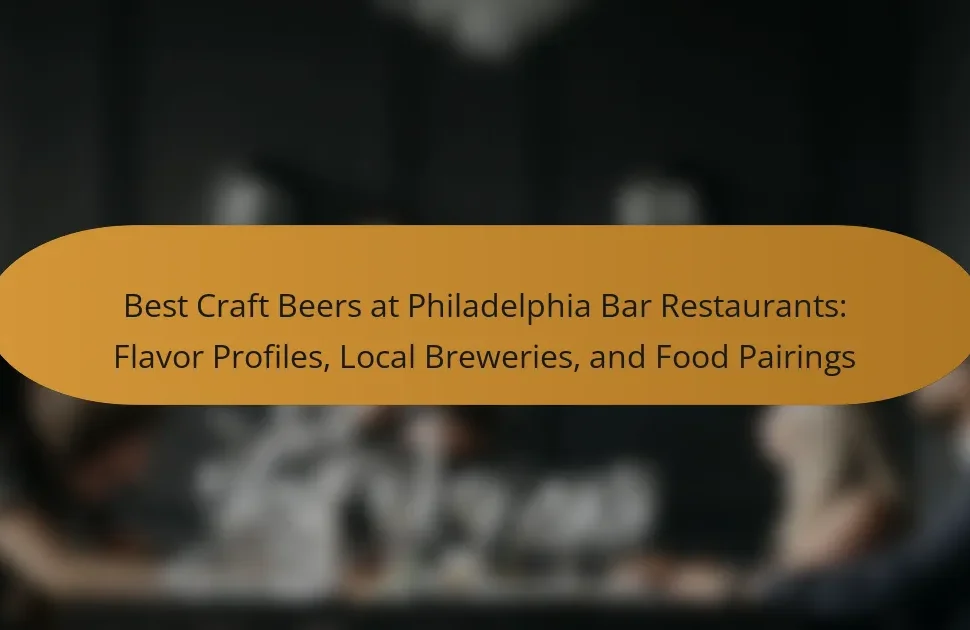
What is Late-Night Dining at Philadelphia Bar Restaurants?
Late-night dining at Philadelphia bar restaurants refers to the practice of serving food during late evening hours, typically after standard dinner times. Many Philadelphia bar restaurants offer extended hours, often until 1 AM or later. This dining option caters to patrons looking for a meal after attending events or socializing. Menus may include a variety of comfort foods, snacks, and shareable plates. Popular items often feature burgers, wings, and artisanal pizzas. Late-night dining enhances the nightlife experience in Philadelphia. It provides a social atmosphere for friends and visitors. Many establishments have adapted their menus to include late-night specials. This trend reflects the city’s vibrant culinary scene.
How has late-night dining evolved in Philadelphia’s bar scene?
Late-night dining in Philadelphia’s bar scene has significantly evolved over the past decade. Initially, many bars offered limited options, primarily focused on traditional pub fare. Today, the late-night menu has expanded to include diverse cuisines and gourmet options. Many establishments now feature food trucks and pop-up kitchens to enhance variety.
The rise of craft beer and cocktails has also influenced food pairings, leading to curated menus that complement drinks. Health-conscious choices are increasingly available, catering to a more diverse clientele. Additionally, the demand for late-night dining has led to extended hours and special promotions.
The shift reflects changing consumer preferences for quality and variety in late-night dining experiences. Statistics show that late-night food sales have increased, indicating a growing trend. This evolution has made Philadelphia’s bar scene more vibrant and appealing to a wider audience.
What historical factors have influenced late-night dining in Philadelphia?
Late-night dining in Philadelphia has been influenced by various historical factors. The city’s industrial past created a workforce that required late-night food options. Significant immigration waves brought diverse culinary traditions, enriching the late-night dining scene. The establishment of bars and taverns during the Prohibition era led to a culture of late-night socializing. Additionally, the rise of universities and nightlife districts increased demand for food after hours. Events like sports games and concerts further drove late-night dining popularity. These factors collectively shaped the vibrant late-night dining landscape in Philadelphia.
How do cultural trends impact late-night dining preferences?
Cultural trends significantly influence late-night dining preferences. For instance, the rise of health-conscious eating has led to increased demand for healthier late-night options. Many diners now prefer plant-based dishes or lighter fare over traditional heavy meals. Additionally, trends in social media impact dining choices. Many consumers seek Instagrammable food experiences during late-night outings. This shift encourages restaurants to create visually appealing dishes. Furthermore, cultural movements, such as the emphasis on local sourcing, drive preferences for regional ingredients. As a result, late-night menus are evolving to reflect these cultural shifts. Research indicates that consumers are more likely to choose establishments that align with their values. Therefore, cultural trends play a crucial role in shaping what diners seek during late-night hours.
What are the key characteristics of late-night dining at bar restaurants?
Late-night dining at bar restaurants typically features a casual atmosphere and a diverse menu. These establishments often serve food until the early morning hours, catering to late-night crowds. Menu items usually include appetizers, comfort foods, and shareable plates. Alcoholic beverages are prominently featured, with many bars offering drink specials. The ambiance is often lively, with music and social interactions enhancing the experience. Many bar restaurants also provide outdoor seating options for patrons. Additionally, late-night dining can attract a younger demographic looking for social experiences. This trend is supported by statistics showing increased late-night sales in urban areas.
What types of cuisines are commonly offered during late-night dining?
Common types of cuisines offered during late-night dining include American, Mexican, and Asian. American cuisine often features burgers, fries, and pizza. Mexican offerings may include tacos, burritos, and quesadillas. Asian cuisine typically presents dishes like sushi, ramen, and stir-fries. These cuisines are popular due to their accessibility and appeal. Late-night dining often caters to diverse tastes, making these options widely available. Many bar restaurants in Philadelphia emphasize these cuisines to attract late-night patrons.
How do menu offerings differ from regular dining hours?
Menu offerings during late-night dining hours often differ from those available during regular dining hours. Many restaurants feature a limited menu late at night. This may include smaller plates or snacks rather than full meals. Additionally, late-night menus often emphasize comfort foods. Items like burgers, fries, and shareable appetizers are common. Some establishments may offer exclusive late-night specials. These can attract customers looking for unique options after hours. The focus on quick, satisfying dishes aligns with late-night dining trends. Research indicates that late-night diners typically seek convenience and indulgence.
What makes late-night dining popular in Philadelphia?
Late-night dining is popular in Philadelphia due to its vibrant food scene and diverse culinary options. The city offers a variety of late-night eateries, from food trucks to upscale restaurants. Many establishments cater to night owls and shift workers, providing convenient dining hours. The nightlife in Philadelphia contributes to the demand for late-night meals. Events, concerts, and bars often lead to increased foot traffic. Additionally, local favorites like cheesesteaks and soft pretzels are popular choices for late-night snacks. The city’s late-night dining culture reflects its community’s social habits and lifestyle.
What demographic factors contribute to the popularity of late-night dining?
Young adults and college students significantly contribute to the popularity of late-night dining. This demographic often seeks social experiences after traditional dining hours. Many are looking for convenience and accessibility to food late at night. Urban areas with nightlife attract this group due to their vibrant environments. Additionally, shift workers and night owls also frequent late-night dining establishments. Research indicates that 18-34 year-olds are the primary consumers of late-night meals. According to a National Restaurant Association report, 40% of late-night diners fall within this age range. This trend is driven by lifestyle choices and social activities that extend into the late hours.
How do social events and nightlife trends influence late-night dining choices?
Social events and nightlife trends significantly influence late-night dining choices. Increased social activity leads to higher demand for dining options after hours. Events like concerts, sports games, and festivals create a surge in late-night patrons. Nightlife trends, such as the popularity of craft cocktails, also shape menu offerings. Restaurants often adapt their menus to include shareable plates and late-night snacks. Research indicates that 60% of diners prefer casual dining experiences post-event. This trend encourages restaurants to extend hours and develop special late-night menus. Additionally, social media influences dining decisions by highlighting trending spots and dishes.

What are the menu highlights of late-night dining at Philadelphia bar restaurants?
Late-night dining at Philadelphia bar restaurants often features a variety of comfort foods. Popular menu highlights include burgers, loaded fries, and wings. Many establishments offer unique twists on classic dishes. For example, gourmet burgers may include specialty toppings like avocado or fried eggs. Additionally, craft cocktails and local beers are common beverage options. Some bars provide late-night breakfast items, such as omelets or pancakes. Seasonal specials may also be available, reflecting local ingredients. These offerings cater to diverse tastes and late-night cravings.
What signature dishes are commonly featured in late-night menus?
Signature dishes commonly featured in late-night menus include burgers, fries, and wings. These items are popular due to their convenience and satisfying nature. Many late-night menus also offer nachos and pizza, appealing to those seeking comfort food. Additionally, breakfast items like omelets and pancakes are frequently available. Salads and wraps may also be included for lighter options. Specialty cocktails and craft beers often accompany these dishes. The combination of these offerings caters to diverse late-night cravings.
How do local ingredients influence late-night dining options?
Local ingredients significantly enhance late-night dining options by providing freshness and authenticity. They allow restaurants to create unique dishes that reflect regional flavors. For example, using locally sourced cheeses can elevate a simple late-night snack into a gourmet experience. Additionally, local ingredients often support sustainability, as they reduce transportation costs and emissions. This practice can attract environmentally conscious diners. Furthermore, restaurants that emphasize local sourcing can differentiate themselves in a competitive market. A survey by the National Restaurant Association found that 73% of consumers prefer restaurants that serve locally sourced food. This preference can drive late-night traffic to establishments that prioritize local ingredients.
What unique beverages are offered alongside late-night meals?
Unique beverages offered alongside late-night meals include craft cocktails, specialty beers, and unique soft drinks. Craft cocktails often feature local spirits and seasonal ingredients. Specialty beers may include local brews or rare imports. Unique soft drinks can consist of artisanal sodas or house-made lemonades. These beverages complement the late-night dining experience by enhancing flavors and providing variety. Many Philadelphia bar restaurants curate their drink menus to pair well with their late-night food offerings.
How do late-night menus cater to diverse dietary preferences?
Late-night menus cater to diverse dietary preferences by offering a variety of options. These menus typically include vegetarian, vegan, and gluten-free choices. Many establishments recognize the growing demand for healthier options. They often feature dishes made from fresh, whole ingredients. Late-night offerings may also include comfort foods that appeal to a wide audience. Some restaurants provide customizable meals to accommodate specific dietary needs. Additionally, many late-night menus highlight local and seasonal ingredients. This approach enhances flavor while supporting local agriculture. Overall, late-night menus are designed to be inclusive and appealing to all diners.
What vegetarian and vegan options are available for late-night diners?
Late-night diners can find various vegetarian and vegan options. Common choices include veggie burgers, salads, and plant-based tacos. Many bars offer vegan pizzas topped with vegetables and dairy-free cheese. Additionally, some establishments serve hummus platters with pita and vegetables. Vegan wings made from cauliflower are increasingly popular. Many places also feature grain bowls with quinoa or rice and assorted vegetables. These options cater to the growing demand for plant-based meals. According to a report by the Plant Based Foods Association, the plant-based food market has grown significantly in recent years, indicating a rise in availability.
How do gluten-free offerings enhance the late-night dining experience?
Gluten-free offerings enhance the late-night dining experience by providing inclusive options for diners with dietary restrictions. Many people are sensitive to gluten, and having gluten-free choices allows them to enjoy a meal without health concerns. This inclusivity can attract a broader clientele, increasing customer satisfaction. Additionally, gluten-free dishes often feature fresh ingredients, promoting healthier eating. Research indicates that 1 in 100 people have celiac disease, making gluten-free options essential for accommodating this demographic. Offering gluten-free meals can also improve a restaurant’s reputation for being health-conscious and modern. This strategy can lead to increased repeat business and positive word-of-mouth recommendations.

What health considerations should diners keep in mind for late-night dining?
Diners should consider portion sizes and nutritional content when engaging in late-night dining. Eating large portions can lead to discomfort and disrupted sleep. High-calorie foods often found in late-night menus can contribute to weight gain. Additionally, diners should be mindful of alcohol consumption, as it can impair judgment and lead to overeating. It is also important to choose lighter, healthier options to avoid digestive issues. Foods high in sugar and fat can exacerbate these problems. Staying hydrated is crucial, as late-night dining can lead to dehydration. Overall, making informed choices can enhance the late-night dining experience while promoting health.
What nutritional aspects should be considered when choosing late-night meals?
When choosing late-night meals, consider the nutritional balance of macronutrients. Meals should include a mix of proteins, healthy fats, and complex carbohydrates. Protein supports muscle repair and satiety. Healthy fats, such as those from avocados or nuts, provide sustained energy. Complex carbohydrates, like whole grains, help maintain stable blood sugar levels.
Portion size is also crucial. Eating smaller portions can prevent discomfort during sleep. Nutrient density should be prioritized. Foods rich in vitamins and minerals support overall health. Avoid high-sugar and high-fat options, as they can disrupt sleep quality.
Hydration is important too. Opt for water or herbal teas instead of sugary drinks. Fiber content should be considered, as it aids digestion and promotes fullness. Finally, timing matters; aim to eat at least two hours before bedtime to allow for proper digestion.
How can diners balance indulgence with healthier choices during late-night dining?
Diners can balance indulgence with healthier choices during late-night dining by selecting lighter menu options. Many Philadelphia bar restaurants offer dishes that incorporate vegetables and lean proteins. Choosing grilled items over fried ones reduces calorie intake significantly. Opting for smaller portions can also help maintain a balance between indulgence and health. Additionally, diners can share richer dishes with friends to enjoy flavors without overindulging. Drinking water or low-calorie beverages instead of sugary cocktails can further support healthier choices. Studies indicate that mindful eating practices enhance satisfaction while promoting better food choices.
What role does portion size play in late-night dining health considerations?
Portion size significantly influences health considerations in late-night dining. Larger portions can lead to overeating, contributing to weight gain and related health issues. Research indicates that consuming large meals late at night disrupts metabolic processes. This disruption can increase the risk of obesity and diabetes. In contrast, smaller portions can help regulate calorie intake and promote healthier eating habits. Studies show that mindful portion control is essential for maintaining a balanced diet, especially during late-night dining.
How does late-night dining impact overall health and wellness?
Late-night dining negatively impacts overall health and wellness. Consuming food late at night can disrupt circadian rhythms. This disruption may lead to poor sleep quality. Research indicates that inadequate sleep is linked to obesity and metabolic disorders. Additionally, late-night meals are often high in calories and low in nutritional value. High calorie intake at night can contribute to weight gain. Studies show that late-night eating is associated with increased risk of chronic diseases. For instance, a study published in the journal “Obesity” found that late eaters tend to have higher body mass indices. Thus, late-night dining can adversely affect health and wellness.
What are the potential effects of late-night eating on sleep patterns?
Late-night eating can negatively impact sleep patterns. Consuming food close to bedtime may lead to difficulties in falling asleep. It can also cause disruptions during the night, resulting in fragmented sleep. Foods high in fat and sugar can exacerbate these issues. Research indicates that late-night meals are associated with increased wakefulness. A study published in the Journal of Clinical Sleep Medicine found that late eaters reported poorer sleep quality. Additionally, late-night eating can alter circadian rhythms, affecting overall sleep health.
How can late-night dining be enjoyed without compromising health?
Late-night dining can be enjoyed healthily by choosing lighter, nutrient-dense foods. Opt for grilled proteins like chicken or fish instead of fried options. Incorporate plenty of vegetables into meals for added fiber and vitamins. Whole grains, such as quinoa or brown rice, can be a healthier carbohydrate choice. Avoid heavy sauces and dressings that add unnecessary calories and fats. Limit portion sizes to prevent overeating late at night. Hydration is also crucial; drink water or herbal teas instead of sugary beverages. Research indicates that late-night meals high in nutrients can support metabolic health and overall well-being.
What tips can enhance the late-night dining experience at bar restaurants?
Enhancing the late-night dining experience at bar restaurants can be achieved through several practical tips. First, choose a bar with a diverse late-night menu. Options like small plates and shareable dishes can encourage social dining. Second, consider the ambiance; a well-lit, inviting atmosphere can enhance comfort. Third, opt for bars with live music or entertainment to create a lively environment. Fourth, check for happy hour specials or discounts on late-night menu items. This can provide value while enjoying a meal. Fifth, engage with staff for recommendations; they often know the best dishes and drink pairings. Lastly, arrive with a group to share dishes and drinks, making the experience more enjoyable. These strategies contribute to a memorable late-night dining outing.
Late-night dining at Philadelphia bar restaurants is characterized by extended hours and diverse menu offerings, catering to patrons seeking food after traditional dining times. The article explores the evolution of late-night dining, highlighting the shift from limited pub fare to gourmet options, influenced by cultural trends and local ingredients. Key aspects include popular menu items, the impact of social events on dining choices, and health considerations for late-night eaters. Additionally, it addresses how restaurants adapt their offerings to accommodate various dietary preferences, emphasizing the importance of balance between indulgence and health.




